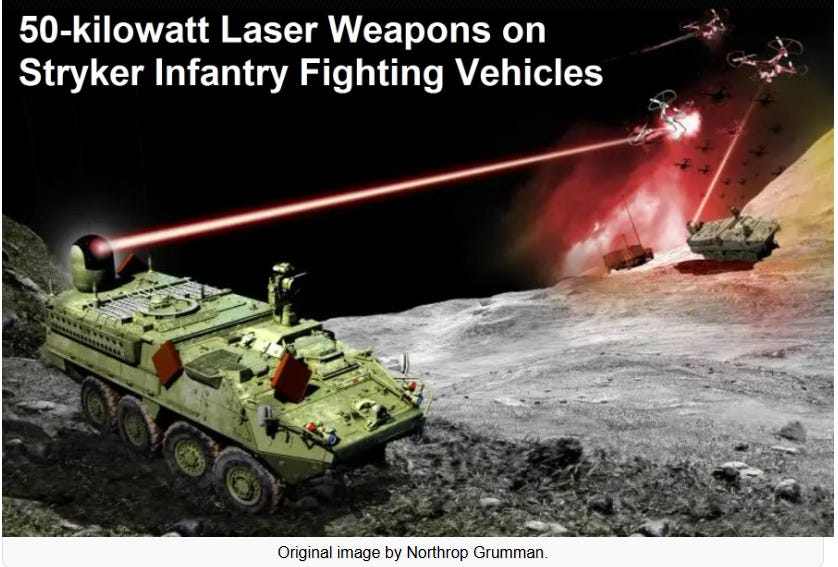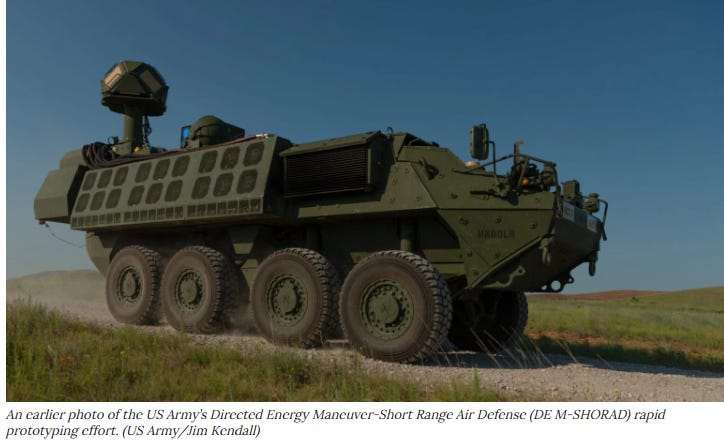EXCLUSIVE: U.S. Military Sent 4 Stryker Vehicles With 50KW First Generation Laser Energy Weapons to the Middle East for Testing
So where else might we see new energy weapons being tested? Some have suggested that they are being used to cause “wildfires” such as in Maui and now throughout the Texas Panhandle.
By ASHLEY ROQUE
March 3, 2024
CAMP PENDLETON, Calif. — Early last month, the US Army sent four Stryker-mounted 50-kilowatt laser prototypes to the Middle East for real-world testing that includes facing down dust particles, the service’s new vice chief, Gen. James Mingus, revealed to Breaking Defense.
“It’s a prototype, but we want to experiment in a live environment,” Mingus said Wednesday in his first interview since being sworn in as the vice-chief in January. “Is it 100 percent ready? Is it going to work perfectly? Probably not, but we’re going to learn from it.”
At a breakfast in February, Army Chief Gen. Randy George said the US Central Command (CENTCOM) region is aligned to receive new counter-unmanned aerial systems (C-UAS) as part of his new “transforming in contact” push where users, developers and testers can converge and provide feedback.
Part of that initiative seemingly includes the Directed Energy Maneuver Short-Range Air Defense (DE M-SHORAD) prototype that integrates a 50-kilowatt laser onto Strykers to down class 1 to 3 aerial drones and incoming rockets, artillery and mortars. (Kord Technologies was tasked with integrating an RTX laser onto combat vehicles.)
Four of those prototypes arrived in CENTCOM’s area of operations in early February, and the service has begun initial testing activities but not live-fire ones.
Once they do, Mingus surmised that it may take several months to process observations that could fuel tech maturation and acquisition decisions.
“Our high-energy lasers are so susceptible to weather. That’s why I think this is going to be a great laboratory because anytime there’s a dust storm, anytime there’s that kind of thing, it starts to alter the physics of the light particles that actually shoot that beam,” he said.
One question the service is looking to answer is just which class of lasers is right for the threat set, instead of people simply getting enamored with the power difference between 300-kilowatt lasers versus 50-kilowatt ones.
Specifically, Mingus wants more answers about the directed energy value per square centimeter.
“You may have a 50-kilowatt laser, [but] at 10 kilometers can you put at least four kilowatts in a centimeter square because … that’s what you need to burn through a quarter-inch steel plate?” he asked. “But that’s really hard to get … from a big beam to get the small portion of it on the exact spot to be able to burn at that high intensity and any kind of dust particle or that starts to disrupt that.”
If this experiment series proves fruitful, it could help the service decide if that 50-kilowatt class laser is the right fit, or if it should maybe spend more time looking at a 28-kilowatt option.
At the same time, service leaders are also keeping an eye on logistics concerns associated with keeping high-energy weapons up and running on the battlefield, where higher-tech replacement parts aren’t in plenty.
However because the DE M-SHORAD system is still a prototype and not mass, this round of testing is not representative of the exact challenges soldiers will face on the battlefield since the supply chain remains “shallow.”
“We knew that, but we thought that it was still worth pushing them over there,” he added.
The proliferation of aerial drones on the battlefield in places like Ukraine and in the Red Sea — to include loitering, one-way attack ones — is accelerating a push to develop and field new defense weapons to down them.
CENTCOM, in particular, has in recent months contended with dozens of attacks on US installations in Iraq and Syria — as well as a drone attack in Jordan that killed three American soldiers — though those attacks have taped off since the fatal incident.
While Pentagon leaders note the need for such weapons, they are also grappling with the per-kill cost of launching kinetic interceptors that can be in the millions of dollars.
If directed energy ones like the DE M-SHORAD prove fruitful in mass, it offers a window for significantly lowering that per-unit kill price point and/or providing commanders with a mix of kinetic and directed energy C-UASs to use depending on the threat set or weather conditions.
So where else might we see new energy weapons being tested? Some have suggested that they are being used to cause “wildfires” such as in Maui and now throughout the Texas Panhandle.
READ MORE:





